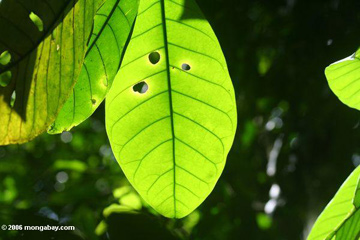Emissions from deforestation offset by increased tree growth in the Amazon
Emissions from deforestation offset by increased tree growth in the Amazon
Rhett A. Butler, mongabay.com
March 10, 2008
An increase in carbon sequestration by trees in the Amazon has roughly offset total emissions from deforestation in the region since the 1980s. A new study, published in Philosophical Transactions of the Royal Society B, this trend may slow in the future, causing the world’s largest rainforest to become a net source of carbon emissions and therefore contributing to climate change.
Under a long-term monitoring project known as ‘RAINFOR‘ (Red Amazonica de Inventarios Forestales or Amazon Forest-Inventory Network), an international team of scientists has found that old-growth forests in the Amazon basin have absorbed at least 490 million tons of carbon — or 1.8 billion tons of carbon dioxide — per year since the early 1980s. Assuming that biomass and leaf litter components have also increased proportionally, the researchers estimate that the old-growth forest sink in the Amazon has been 790 million tons of carbon per year, an amount roughly equal to the carbon emissions from Amazon deforestation. In short, because its trees are storing more carbon, the Amazon has not been a net source of greenhouse gas emissions despite the loss of around 200,000 square miles (520,000 sq km) of forest since 1980.
“Far from being static systems, the evidence shows that old-growth forests in Amazonia have been changing in subtle ways for decades now,” explained Dr. Oliver L. Phillips, lead author and a researcher at the Earth and Biosphere Institute of the School of Geography at the University of Leeds. “The rate at which trees grow and die (‘turnover’) has been picking up, and with the gains in growth generally leading the gains in mortality so that forests are providing a long-term carbon sink. The magnitude of this sink has been approximately equal to the large source from Amazon deforestation.”

|
Phillips and colleagues say that while this increased rate of carbon sequestration has helped offset expected emissions from deforestation, higher plant respiration due to higher temperature, increased mortality resulting from drought, and greater forest disturbance could transform the Amazon into a net source of emissions, worsening global warming.
“There are good reasons – such as the increased risk of drought in a changing climate – for thinking this sink will shut down soon, and so potentially increasing the rate of increase in atmospheric carbon dioxide,” Phillips told mongabay.com.
“Any switch from carbon sink to source would have profound implications for global climate, biodiversity and human welfare, while the documented acceleration of tree growth and mortality may already be affecting the interactions among millions of species,” the authors write.
Phillips says that while there is still a lot of uncertainty on how the Amazon will respond to deforestation and climate change, continued monitoring will help researchers understand forecast future changes in the region.
“These results are based on careful remeasurement of dozens of long-term forest sites across the Amazon, by the RAINFOR network of foresters and ecologists,” said Phillips. “They show the vital importance of having long-term, standardized monitoring on-the-ground to find out how forests are responding to our changing world.”
Oliver Phillips et al (2008). The changing Amazon forest [FREE OPEN ACCESS]. Phil. Trans. R. Soc. B, DOI: 10.1098/rstb.2007.0026














